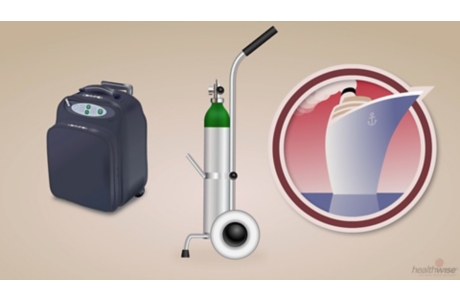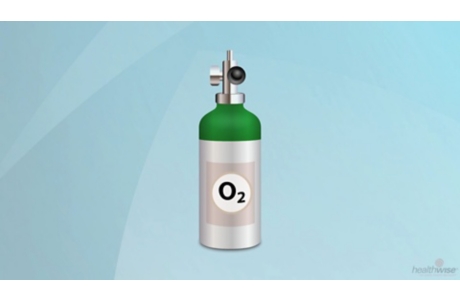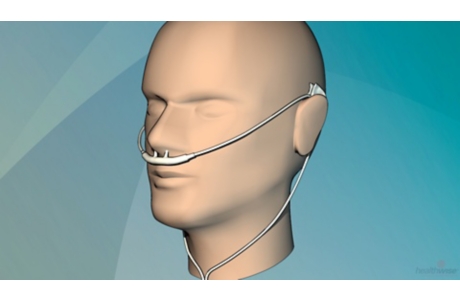Oxygen Treatment for Chronic Obstructive Pulmonary Disease (COPD)
Treatment Overview
Oxygen treatment increases the amount of oxygen that flows into your lungs and bloodstream. If your COPD is very bad and your blood oxygen levels are low, getting more oxygen can help you breathe better and live longer.
There are several ways to deliver the oxygen, including:
- Oxygen concentrators.
- Oxygen-gas cylinders.
- Liquid-oxygen devices.
You don’t have to stay at home or in a hospital to use oxygen. Oxygen systems are portable. You can use them while you do your daily tasks.
People using oxygen should not smoke.
Do not use oxygen around lit cigarettes or an open flame. If you or those who care for you smoke, or if there are other risks for fire, it is important to consider oxygen treatment very carefully because of the danger of fire or explosion.
What To Expect
Long-term oxygen treatment may improve your quality of life. It can help you live longer when you have severe COPD and low oxygen levels. You may notice less shortness of breath and have more energy.
Why It Is Done
Long-term oxygen therapy is used for COPD if you have low levels of oxygen in your blood (hypoxia). It is used mostly to slow or prevent right-sided heart failure. It can help you live longer.
Oxygen may be given in a hospital if you have a rapid, sometimes sudden, increased shortness of breath (COPD exacerbation). Oxygen can also be used at home if the oxygen level in your blood is too low for long periods.
Long-term oxygen therapy should be used for at least 15 hours a day with as few interruptions as possible. Regular use can reduce the risk of death from low oxygen levels.footnote 1 To get the most benefit from oxygen, you use it 24 hours a day.
Your need for oxygen depends on your health status and the results of oximetry or an arterial blood gas test.
You may need oxygen in certain situations, including:
- During exercise. For some people with COPD, blood oxygen levels drop only when they exercise or are very active. Using oxygen during exercise may help boost performance and reduce shortness of breath for some people. But there are no studies that show any long-term benefits from using oxygen during exercise.
- During sleep. During sleep, breathing naturally slows down because the body doesn’t need as much oxygen. Sleep-related breathing disorders are quite common in people with COPD, and many will have significantly low blood oxygen levels during sleep.
- For air travel. The level of oxygen in airplanes is about the same as the oxygen level at an elevation of 8000 ft (2400 m). This drop in oxygen can really affect people with COPD. If you normally use oxygen or have borderline-low oxygen levels in your blood, you may need oxygen when you fly. Traveling with oxygen usually is possible. But it is important to plan ahead before you travel.
How Well It Works
Several studies show that using oxygen at home for more than 15 hours a day increases quality of life and helps people live longer when they have severe COPD and low blood levels of oxygen.footnote 1, footnote 2 Oxygen therapy has good short-term and long-term effects in people who have COPD.
Using oxygen may also improve confusion and memory problems. It may improve impaired kidney function caused by low oxygen levels.
Risks
Typically there are no risks from oxygen treatment as long as you follow your doctor’s instructions. But oxygen is a fire hazard, so it is important to follow safety rules. Do not use oxygen around lit cigarettes, open flames, or anything flammable.
Oxygen is usually prescribed to raise the PaO2 to between 60 and 65 mm Hg or the saturations from 90% to 92%. Higher flow rates usually do not help, and they can even be dangerous.
References
Citations
- McIvor RA, et al. (2011). COPD, search date April 2010. Online version of BMJ Clinical Evidence: http://www.clinical evidence.com.
- Global Initiative for Chronic Obstructive Lung Disease (2017). Global strategy for the diagnosis, management, and prevention of chronic obstructive pulmonary disease. http://goldcopd.org/gold-2017-global-strategy-diagnosis-management-prevention-copd. Accessed November 27, 2016.
Other Works Consulted
- Global Initiative for Chronic Obstructive Lung Disease (2017). Global strategy for the diagnosis, management, and prevention of chronic obstructive pulmonary disease. http://goldcopd.org/gold-2017-global-strategy-diagnosis-management-prevention-copd. Accessed November 27, 2016.
- Long-Term Oxygen Treatment Trial Research Group (2016). A randomized trial of long-term oxygen for COPD with moderate desaturation. New England Journal of Medicine, 375(1): 1617–1627. DOI: 10.1056/NEJMoa1604344. Accessed November 7, 2016.
Credits
Current as of: June 9, 2019
Author: Healthwise Staff
Medical Review:E. Gregory Thompson, MD – Internal Medicine & Kathleen Romito, MD – Family Medicine & Adam Husney, MD – Family Medicine & Hasmeena Kathuria, MD – Pulmonology, Critical Care Medicine, Sleep Medicine
Current as of: June 9, 2019
Author: Healthwise Staff
Medical Review:E. Gregory Thompson, MD – Internal Medicine & Kathleen Romito, MD – Family Medicine & Adam Husney, MD – Family Medicine & Hasmeena Kathuria, MD – Pulmonology, Critical Care Medicine, Sleep Medicine
This information does not replace the advice of a doctor. Healthwise, Incorporated, disclaims any warranty or liability for your use of this information. Your use of this information means that you agree to the Terms of Use. Learn how we develop our content.




